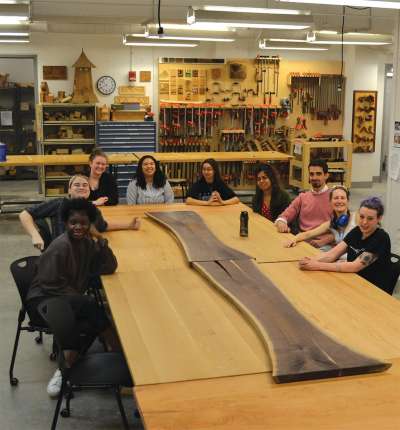
A view of the table in almost-finished form, with its components put together around the walnut live-edge center. Photos in this series are by student Olivia Wiktor, with contributions from Carolyn Lowell and Nicole Garcia.
Mitch Ryerson is an artist, designer, and craftsman of fine furniture. In recent years, he has also created play structures for schools and parks. He uses Berkshires-sourced black locust for this purpose, taking full creative advantage of the trees’ twisting growth patterns.
“I have giant, crazy trees shipped to my field,” he said. “I chainsaw and grind them and re-saw them to my heart’s content.”
Ryerson’s experience with regionally grown wood and his keen interest in his own land (he manages 17 mostly forested acres for wildlife habitat and sawlogs) inform his work as an instructor at the Massachusetts College of Art and Design. There, he teaches introductory classes in woodworking and includes in his lessons readings on forestry topics.
“A lot of these kids are urban kids who are inclined toward environmentalism quite strongly,” he said. “They’re learning that taking care of forests is a good thing.”
This past autumn, Ryerson’s class focused on a semester-long group project: the design and construction of a conference table for the New England Forestry Foundation (NEFF). In the end, the students opted for a modular design comprised of eight different tables, and five – all regionally sourced – native species of wood. This photo series chronicles the project.
Captions draw from an interview with Ryerson and written comments by Carolyn Lowell, a graduate student in the class. Most of the photos in this series are by student Olivia Wiktor, with contributions from Carolyn Lowell and Nicole Garcia.
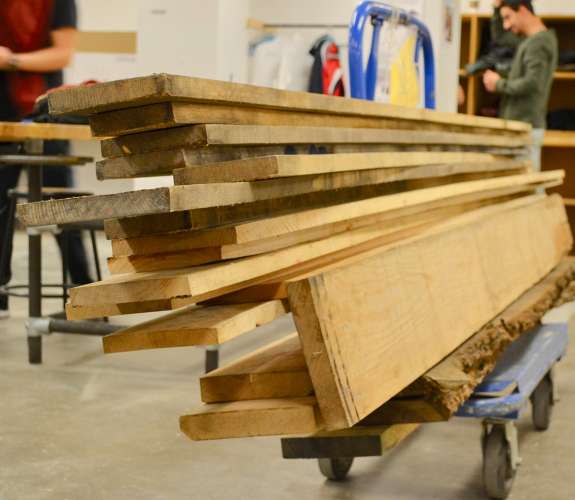
1. Two mills donated wood for the project. Hull Forest Products of Pomfret Center, Connecticut provided thick stock appropriate for furniture making: “[Mary Hull] talked to the yard manager, and they found eight pallets in one of the sheds…I went out and looked at it, and it was just incredible.” There was a variety of six- and eight-quarter stock, including cherry, red oak, and “gorgeous quarter-sawn white oak.” Best of all, there was beautiful, curly maple. Heyes Forest Products in Orange, Massachusetts provided additional maple and cherry.
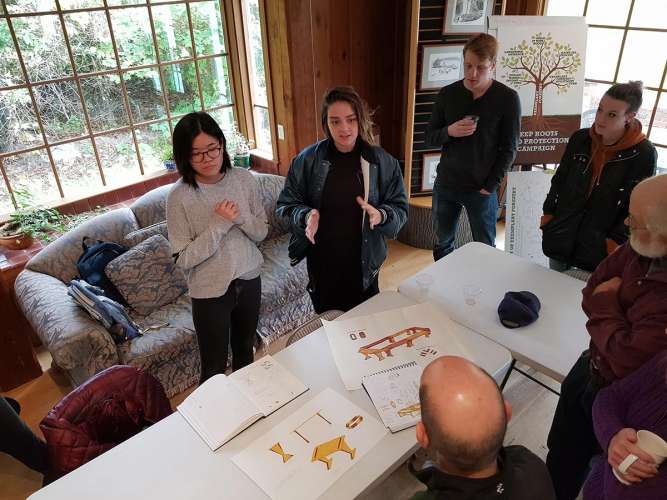
2. “The whole [NEFF] staff came into the conference room and listened to their proposals,” said Ryerson. “[The] experience of having a client was really valuable.” Left to right: Michelle He Lam, Cassidy Silva, Teaching Assistant Joe Sheehan, and Melanie Forster.
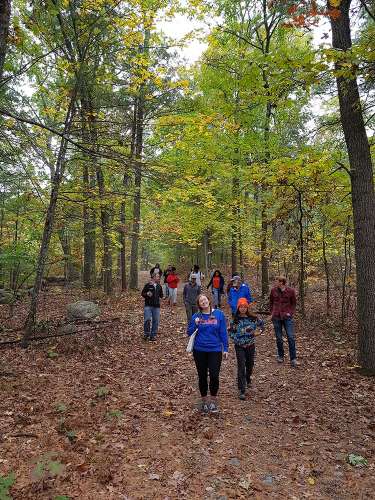
3. During the visit to NEFF, the group also took a tour of Prouty Woods Community Forest.
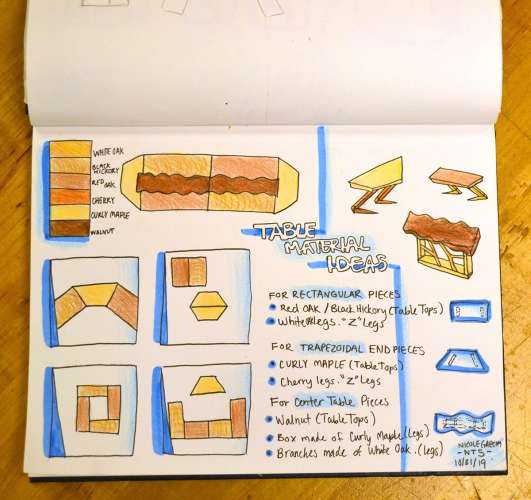
4. “We made a final proposal of eight tables,” wrote Lowell, “four rectangular tables, two trapezoidal tables, and two slightly taller and thinner tables with a live edge – that incorporated aspects of each group’s design. The taller, thinner tables were designed to fit between the [other] tables when arranged in a long configuration, with their tops slightly overlapping the rectangular tables below.…We designed an eye-catching curly maple box surrounding thinner strips of walnut [that were] meant to look like branches to support the live-edge walnut top.”
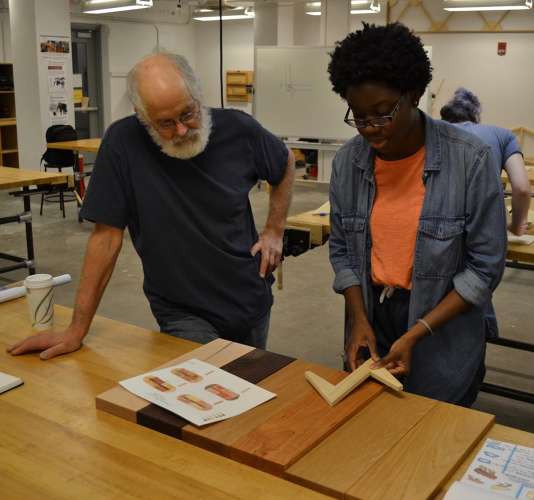
5. The final design includes Z shape legs. “Their origin was the trunk, the root going out horizontally, and then another branch going out horizontally from the top,” explained Ryerson. Here, Hazel Afamefuna and Ryerson review the design.
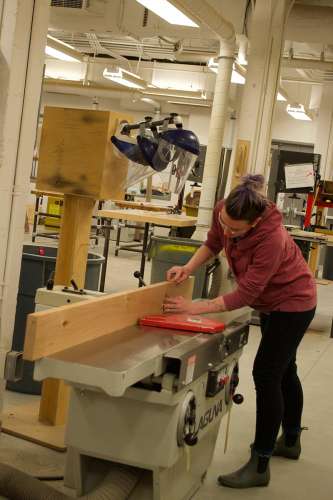
6. “We began milling rough-sawn stock for the tabletops,” wrote Lowell. Melanie Forster joints the edge of a cherry board.
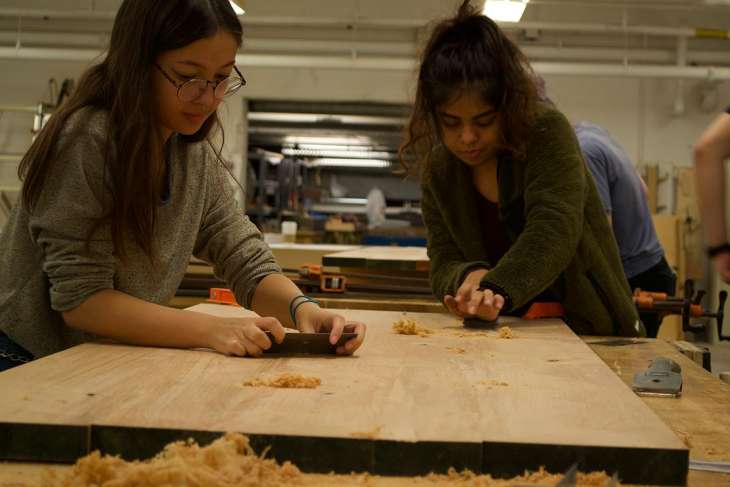
7. Sina Seri and Itisha Srivastava use card scrapers to smooth the cherry tabletop.

8. A closer look at the curly maple legs. “When you mill it and put some oil on it, you could just sit there and stare at it,” said Ryerson. “Mostly in the shop, the school supplies poplar for the student projects. It’s covered by lab fees…So to come and have this amazing wood land in the shop…I think that has made a big impression on the students. And it’s from right here. You don’t need to go to Zanzibar.”
Web Extras
Students at Massachusetts College of Art and Design documented their project for the New England Forestry Foundation (NEFF) by taking photographs at every stage of the design process. Below is a slide show from that process, and here is a power point presentation: Sustainable Furniture Fabrication: New Table for the New England Forestry Foundation.
We also asked the class to weigh the table components by species, in order to estimate how much carbon is sequestered in the final form: 348 pounds.
Thanks to Carla Fenner at NEFF for reviewing our calculations.